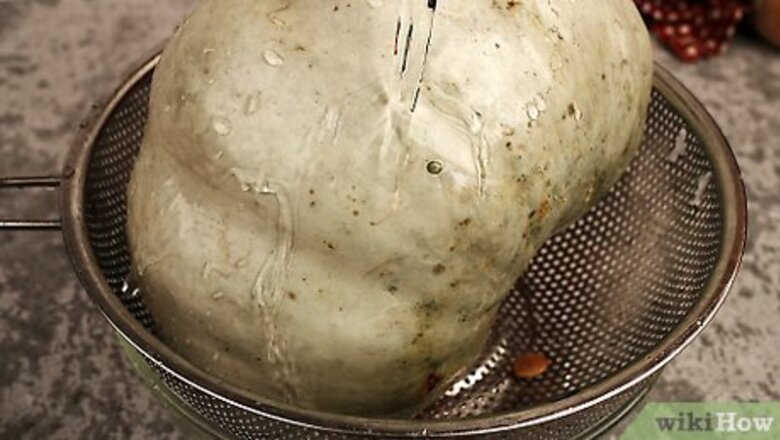
views
Washing and Cutting the Pumpkin
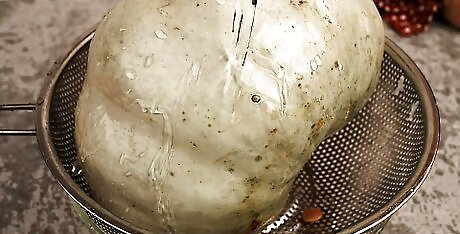
Wash the skin. Rinse the pumpkin under running water and scrub the skin and around the stem area with a vegetable brush or cloth. This will remove any dirt or residue from the growing or shipping process. Pat the pumpkin dry with a clean towel. It’s not necessary to use soap, detergent, or other cleaners to wash produce.
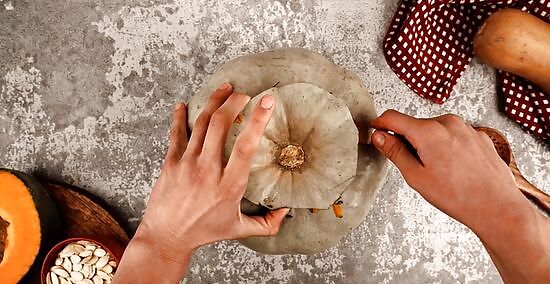
Cut out the stem. Transfer the pumpkin to a cutting board. Hold the pumpkin in place with one hand and place the tip of a sharp knife 1 inch (2.5 cm) away from the stem. Insert the knife at a 45-degree downward and inward angle to cut around and under the stem. Cut all the way around the stem at this angle, and then pull out the stem. Always be very careful when using sharp knives, and never cut toward your body.
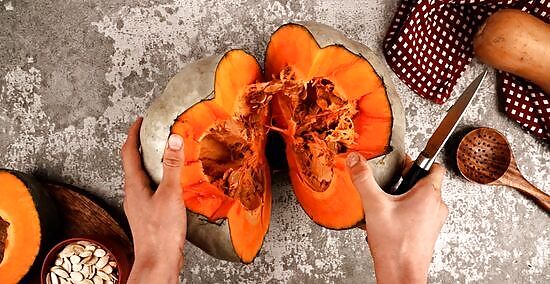
Cut the pumpkin in half. Hold the pumpkin steady with one hand, and use a large chef’s knife to cut the pumpkin in half down the middle. This is another reason why it’s beneficial to use smaller pumpkins, because they're easier to manage and their skin and flesh is easier to cut.
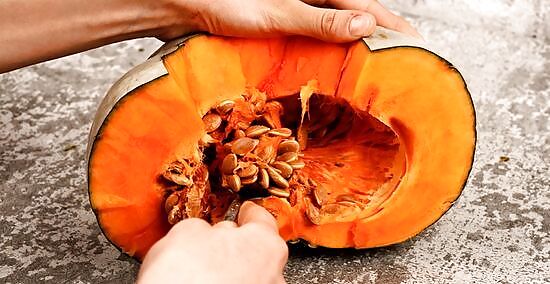
Scoop out the seeds and stringy pulp. Lay the two pumpkin halves on a cutting board, cut sides up. Use a large spoon to scrape out the seeds and stringy pulp from the center of the pumpkin. Discard the stringy bits of flesh.
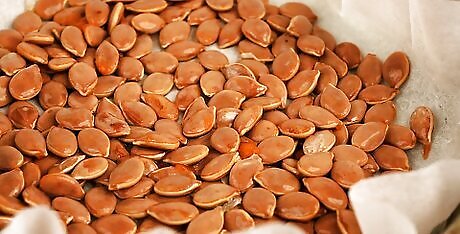
Toast the seeds (optional). Instead of throwing out the seeds, you can keep them to roast if you like. Separate the seeds from the stringy flesh, rinse the seeds, and transfer them to a colander to drain. Spread the seeds out on a baking sheet, drizzle them with oil, and season with salt. Bake the seeds at 325 °F (163 °C) for about 45 minutes, stirring occasionally. Allow the seeds to cool, and enjoy as a snack, on salads, or in baked goods.
Cooking Whole Pumpkin
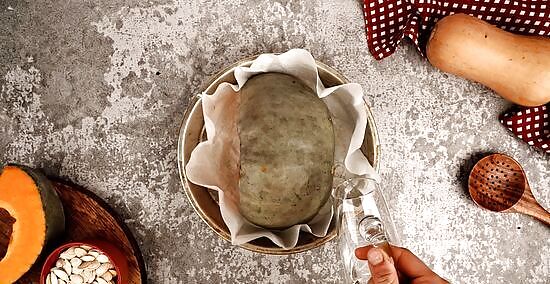
Roast the pumpkin in the oven for 1 hour. Preheat the oven to 300 °F (149 °C). Transfer the 2 pumpkin halves to a baking dish or roasting pan, and arrange them in the dish with the skin sides up. Add ⁄4 inch (0.64 cm) of water to the bottom of the dish to keep the pumpkin moist. Place the pumpkin in the oven and bake it for about an hour, or until the flesh is tender enough to pierce with a fork. Baking pumpkin in the oven is among the most popular cooking methods, because roasting imparts the flesh with a rich flavor.

Slow cook it on high for 4 hours. Transfer the pumpkin halves to the slow cooker with the skins facing up. Add ⁄4 inch (1.9 cm) of water to keep the bottom of the pumpkin from drying out. Put on the lid and set the slow cooker to high. Cook the pumpkin for about 4 hours, until the flesh is tender. Slow cooker pumpkin takes the longest to cook, but the benefit is that you can leave and do other things while the pumpkin is cooking.
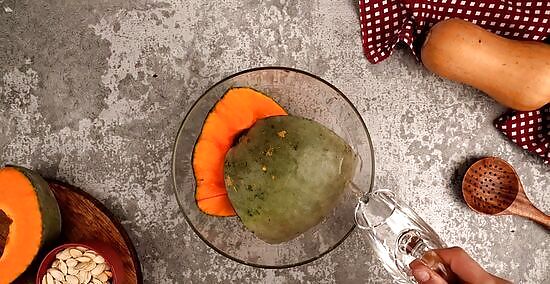
Microwave it for 15 to 20 minutes. Place the pumpkin halves into a large microwave-safe bowl. Add 1 inch (2.5 cm) of water and cover the dish with a microwave-safe lid. Leave a corner of the lid unsealed to allow steam to escape. Cook the pumpkin on high for 15 minutes. Test the pumpkin for doneness, and continue cooking in 5-minute increments until the flesh is soft, tender, and easily pierced with a fork. Cooking pumpkin in the microwave is the quickest method.
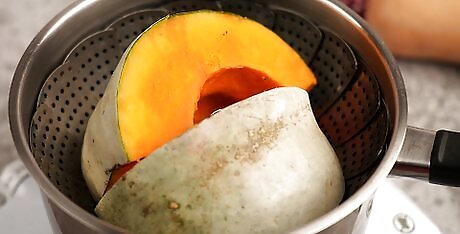
Steam it for 8 to 12 minutes. Insert a metal steamer basket into a large saucepan. Place the pumpkin halves into the steamer basket. Fill the saucepan with 1 to 2 inches (2.5 to 5.1 cm) of water, making sure it’s not actually touching the pumpkin. Put on a lid and bring the water to a boil over medium-high heat. When the water is boiling, reduce the heat to medium and cook the pumpkin for 8 to 12 minutes, until soft. You can also use a dedicated steamer. Fill the bottom reservoir to the minimum fill line and cook the pumpkin for 8 to 12 minutes. The benefit of steaming is that it infuses the skin with lots of water, making it very easy to peel.
Pureeing Cooked Pumpkin
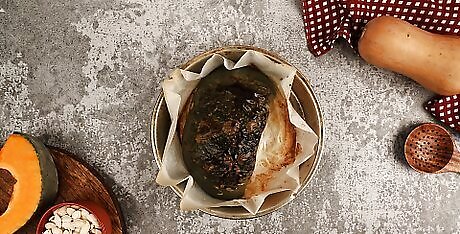
Allow the pumpkin to cool for up to an hour. When the pumpkin is soft and tender, remove it from the oven, slow cooker, microwave, or steamer. Protect your hands with oven mitts and transfer the halves to a wire cooling rack. Set the pumpkin aside to cool for 30 to 60 minutes, until it’s comfortable enough to handle safely.
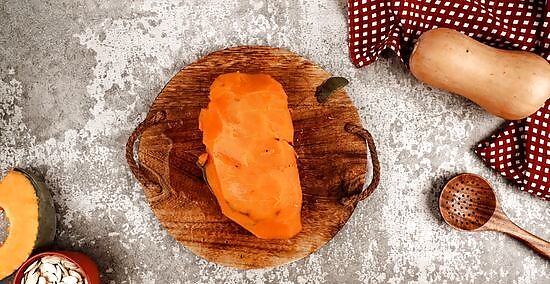
Peel off the skin. When the pumpkin is cool enough to touch, use your fingers to peel the skin away from the tender flesh. The skin will come off in strips, but be careful to leave as much flesh behind as possible. Use a sharp knife to slice away any stubborn areas where the skin doesn’t want to come off.
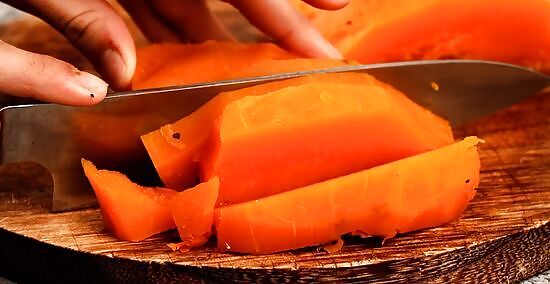
Cut the flesh into cubes. Transfer the peeled pumpkin to a cutting board with the cut sides down. Chop the flesh into 1 inch (2.5 cm) cubes. You can use the cubes for salads, soups, roasts, and other dishes, or you can blend the cubes to make a puree for baked goods and other recipes.
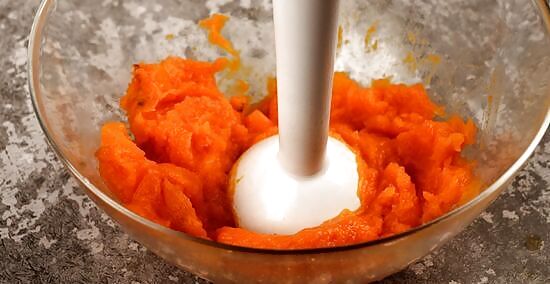
Pulse the pumpkin in a blender. To make a puree, transfer the pumpkin cubes to a blender. Pulse the pumpkin for about 3 minutes, until it’s smooth and free of chunks. Each 6-inch (15-cm) pumpkin will yield between 2 and 3 cups (450 and 675 g) of puree. Instead of a blender, you can also use a food processor, immersion blender, potato masher, or food mill.

Drain the puree in a colander overnight. Line a colander with large disposable coffee filters or clean cheesecloth. Pour the puree into the colander and cover it with plastic wrap. Place the colander over a large bowl and transfer it all to the refrigerator. Leave the puree to drain overnight. If you don’t drain the puree, there will be too much water in the pumpkin, and it will affect the flavor and recipe ratios.
Using and Storing Cooked Pumpkin
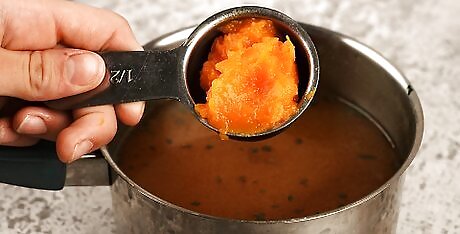
Add it to soups or stews. Pumpkin is a type of squash, and pumpkin soup is similar in texture and flavor to butternut squash soup. You can start with the puree to make a pumpkin soup, or you can add chunks of cooked pumpkin to other soups and stews.

Use it for pie filling. Pumpkin pie is a holiday favorite for Thanksgiving and Christmas desserts, and there's no better way to customize a pie than by using your own homemade pumpkin puree. The best part about homemade puree is that you can spice it however you like, and some popular choices include: Cinnamon Allspice Cloves Ginger Nutmeg
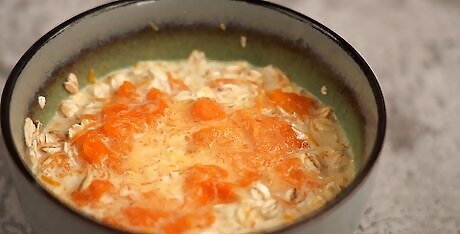
Stir it into oatmeal. Pumpkin puree is a delicious addition to oatmeal, and it gives this breakfast dish a rich and tangy kick. Stir ¼ cup (56 g) of puree into prepared oatmeal and season the dish with your favorite accompaniments, such as brown sugar, cinnamon, ginger, or milk.
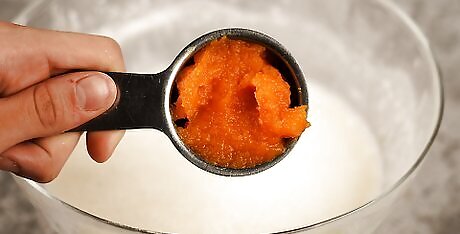
Make pumpkin baked goods. Pumpkin-flavored baked goods are extremely popular in the fall and around the holiday season. There are many different pumpkin baked goods you can make using homemade puree, including: Pumpkin bread or loaf Cookies Pancakes Pumpkin cake
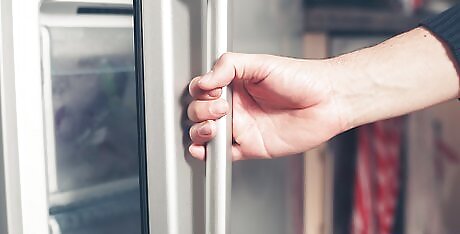
Store excess in the refrigerator for up to a week. Transfer the puree or cubes to an airtight container and place the pumpkin in the refrigerator. As long as it stays chilled and out of the air, the pumpkin will last up to 7 days.

Freeze it for up to 3 months. Transfer the pumpkin puree or cubes to an airtight and freezer-safe container or plastic bag. For easy use, divide the pumpkin into 1-cup (225-g) portions and freeze the portions in individual containers.


















Comments
0 comment